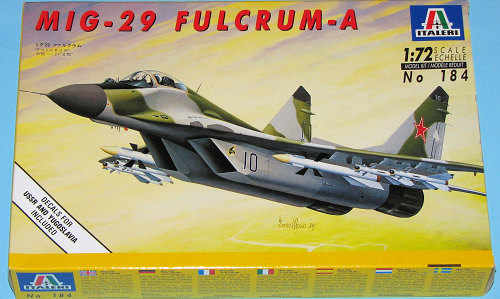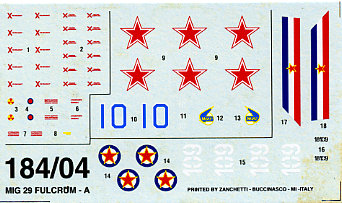
| KIT: | Italeri 1/72 MiG-29 Fulcrum A |
| KIT #: | 184 |
| PRICE: | $ |
| DECALS: | Two options |
| REVIEWER: | Scott Van Aken |
| NOTES: |

| HISTORY |
The history of the MiG-29, like that of the larger Sukhoi Su-27 'Flanker', started in 1969 when the Soviet Union learned of the U.S. Air Force’s 'FX' program, which resulted in the F-15 Eagle. The Soviet leadership soon realized that the new American fighter would represent a serious technological advantage over all existing Soviet fighters. The MiG-21 'Fishbed' was agile by the standards of its day, but had deficiencies in range, armament, and growth potential. The MiG-23 'Flogger', developed to match the F-4 Phantom II, was fast and had more space for fuel and equipment, but lacked in maneuverability and dogfighting ability. What was needed was a better-balanced fighter with both good agility and sophisticated systems. In response, the Soviet General Staff issued a requirement for a Perspektivnyi Frontovoi Istrebitel (PFI, roughly "Advanced Frontline Fighter", directly "Perspective Forward Fighter"). Specifications were extremely ambitious, calling for long range, good short-field performance (including the ability to use austere runways), excellent agility, Mach 2+ speed, and heavy armament. The aerodynamic design for the new aircraft was largely carried out by TsAGI, the Russian aerodynamics institute, in collaboration with the Sukhoi design bureau.
However, in 1971 the Soviets determined that the PFI aircraft would be too expensive to procure in the quantities needed, and divided the requirement into the TPFI (Tyazholyi Perspektivnyi Frontovoi Istrebitel, "Heavy Advanced Tactical Fighter") and the LPFI (Legkiy Perspektivnyi Frontovoi Istrebitel, "Lightweight Advanced Tactical Fighter") programs, the latter paralleling the contemporary USAF decision that led to the "Lightweight Fighter" program and the F-16 Fighting Falcon and YF-17 Cobra. The heavy fighter remained with Sukhoi, resulting in the Su-27 'Flanker', while the lightweight fighter went to Mikoyan. Detailed design work on the resultant Product 9, designated MiG-29A, began in 1974, with the first flight taking place on October 6, 1977. The pre-production aircraft was first spotted by United States reconnaissance satellites in November of that year; it was dubbed Ram-L because it was observed at the Zhukovsky flight test center near the town of Ramenskoye. Early Western speculations suggested that the Ram-L was very similar in appearance to the YF-17 Cobra and powered by afterburning Tumansky R-25 turbojets.
Despite program delays caused by the loss of two prototypes in engine-related accidents, the MiG-29B production version entered service in August 1983 at the Kubinka air base. State acceptance trials where completed in 1984, and deliveries began the same year to the Soviet Frontal Aviation. The workload split between TPFI and PFI became more apparent as the MiG-29 filtered into front-line service with the VVS in the mid-1980s. While the heavy, long range Su-27 was tasked with the more exotic and dangerous role of deep air-to-air sweeps of NATO high-value assets, the smaller MiG-29 directly replaced the MiG-23 in the frontal aviation role. The Fulcrum was positioned relatively close to the front lines, tasked with providing local air superiority to advancing Soviet motorized army units. Rugged landing gear and protective intake grates meant the MiG-29 could operate from the damaged or under-prepared airstrips Soviet war planners expected to encounter during a rapid armored advance. The Fulcrum was also tasked with escort duties for local strike and interdiction air packages, protecting vulnerable ground attack aircraft from NATO fighters such as the F-15 and F-16. Frontal aviation MiG-29s would ensure Soviet ground forces could operate under a safe air umbrella, moving forward with the troops as they advanced.
In the West, the new fighter was given the NATO reporting name "Fulcrum-A" because the pre-production MiG-29A, which should have logically received this designation, remained unknown in the West at that time. The MiG-29B was widely exported in downgraded versions known as MiG-29B 9-12A and MiG-29B 9-12B (for Warsaw Pact and non-Warsaw Pact nations, respectively), with less capable avionics and no capability for delivering nuclear weapons. Total production was about 840 aircraft. The MiG-29 was first publicly seen in the West during a visit to Finland in July 1986. Two were displayed at the Farnborough Air Show in Britain in September 1988. Western observers were impressed by its apparent capability and exceptional agility, but found fault with the excessive smoke generated by its Klimov powerplants.
MiG-29 export customers have included Algeria, Bangladesh, Bulgaria, Cuba, Czechoslovakia, Eritrea, East Germany, Hungary, India, Iran, Iraq, Malaysia, Myanmar, North Korea, Peru, Poland, Romania, Serbia, Slovakia, Syria, and Yemen. The ex-Soviet republics of Belarus, Kazakhstan, Moldova, Turkmenistan, Ukraine, and Uzbekistan were left with large numbers of aircraft after the disintegration of the Soviet Union; some remain in service, others were mothballed or — like the 34 aircraft originally held by Moldova — have been sold abroad.
| THE KIT |
 This kit comes on three sprues, one of them holding a two-piece canopy. The other have nicely engraved detailing, though not quite as crisp as what one finds on the Fujimi or Hasegawa MiG-29 kit. I also suspect that this kit is more accurate than those two, for the Japanese companies were in a rush to get theirs on the shelves and were unable to make accurate measurements of the real aircraft. The date on the box side is 1994.
This kit comes on three sprues, one of them holding a two-piece canopy. The other have nicely engraved detailing, though not quite as crisp as what one finds on the Fujimi or Hasegawa MiG-29 kit. I also suspect that this kit is more accurate than those two, for the Japanese companies were in a rush to get theirs on the shelves and were unable to make accurate measurements of the real aircraft. The date on the box side is 1994.
The kit's cockpit consists of a tub with raised console detail, an instrument panel, also with raised detail, a control stick and a seat. The fuselage is split horizontally and I found flash in the opened upper wing intakes. The kit is designed to be built with the forward intake doors closed as there is no intake trunking. The fins are a single piece and I found some slight sink areas near the base on one of them. The chaff/flare dispensers that one routinely sees on the base of the fins are separate parts, indicating that Italeri had planned on a two seat variant.
 Landing gear are quite convincing and the kit comes with a full complement of under wing pylons. There are also six missiles to fill those pylons. Two long range and four short range types (I'm not very conversant on Russian missiles). No drop tank is supplied. No indication is given if any nose weight is required, though it may well not need it.
Landing gear are quite convincing and the kit comes with a full complement of under wing pylons. There are also six missiles to fill those pylons. Two long range and four short range types (I'm not very conversant on Russian missiles). No drop tank is supplied. No indication is given if any nose weight is required, though it may well not need it.
Instructions are very well done and provide full painting information in generic, Model Master and FS 595 references. A small but well done decal sheet gives markings for two aircraft. Both of these carry different camo schemes. The Russian aircraft is pale green over light gull grey, while the Yugoslav aircraft is light ghost grey over light gull grey. I'm sure the colors are approximate. The Yugoslav painting and decal guide is in full color on the back of the box.
| CONCLUSIONS |
This looks like a very nice kit and since it is probably the newest out there; the most accurate. Thanks to few parts, it should build quickly.
| REFERENCES |
Thanks to me for providing this kit for you.
April 2007
If you would like your product reviewed fairly and fairly quickly by asite that has over 350,000 visitors a month, please contactme or see other details in the